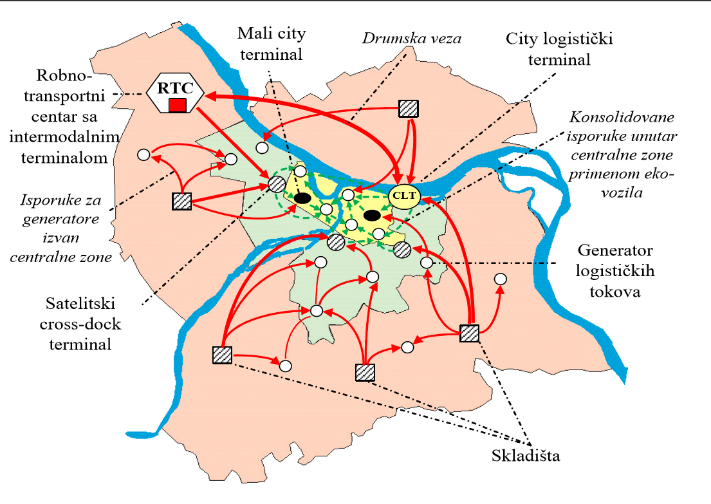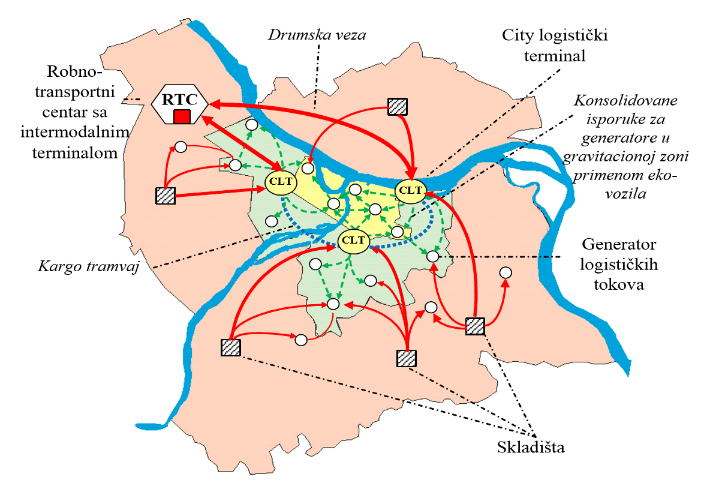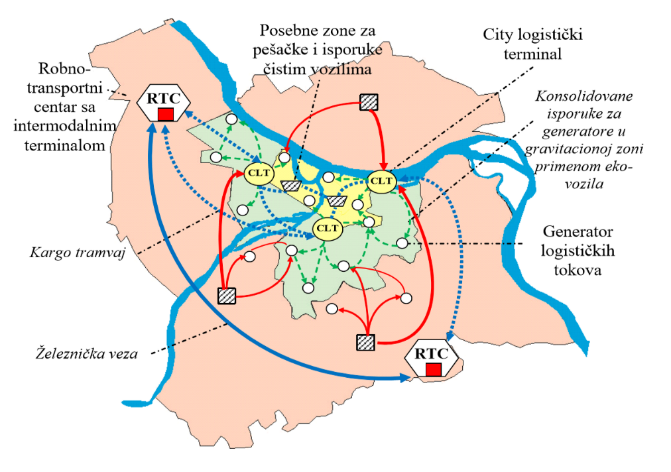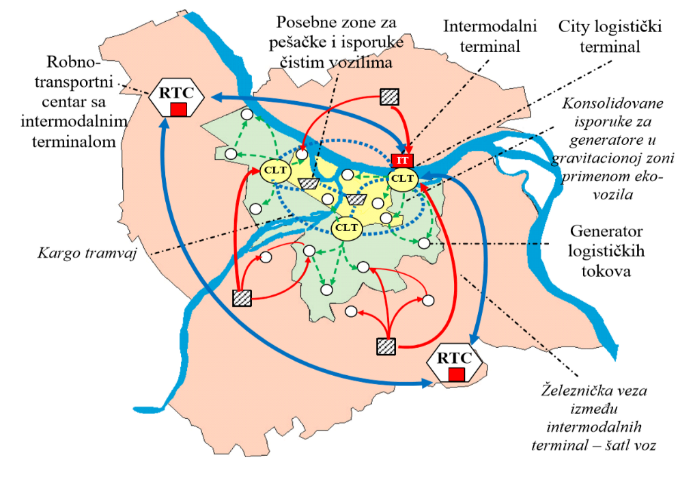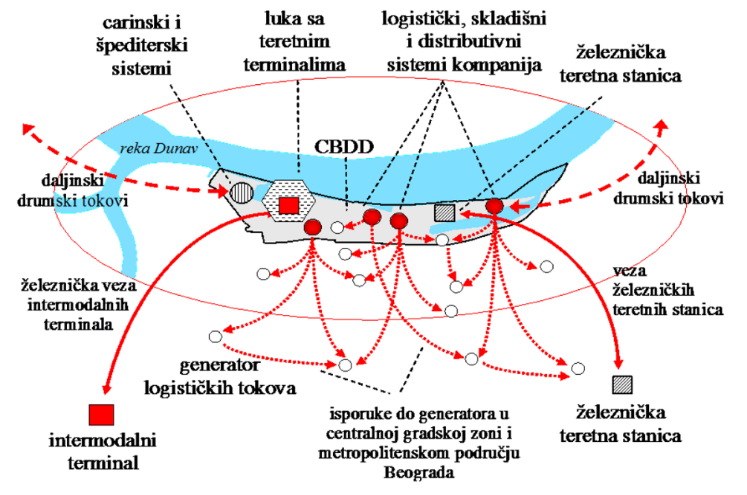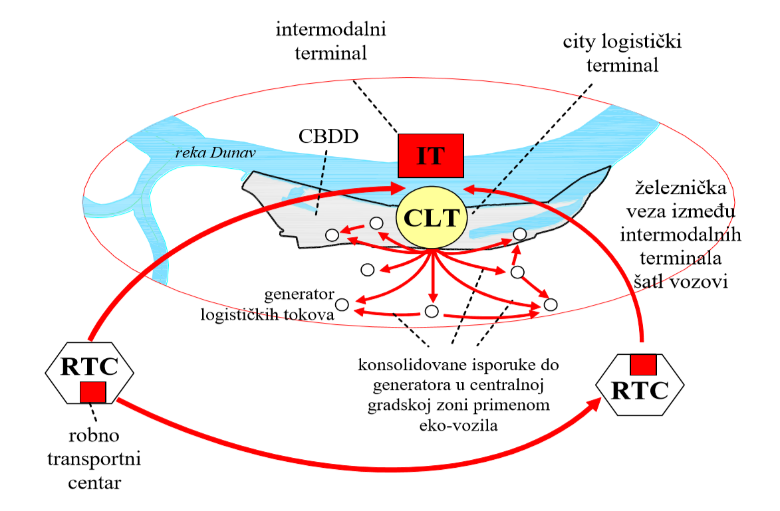Cities are places where large concentrations of people are present, and as such, they generate large quantities of goods. In Europe, 80% of people live in urban areas. Distribution of goods is a fundamental prerequisite for the maintenance of urban life and business activity that generates income and development of urban areas. The distribution of goods within the cities leads to the emergence of "diseases in urban areas", such as traffic congestion, noise, adverse environmental impact, road safety, etc. With a view to sustainable development, increasing attention is paid to the development of environmentally friendly systems and goods transport technologies in the distribution of goods. This paper analyzes the role of vehicles on alternative propulsion systems in logistics and transport
- transport
- logistics
- vehicles
- alternative propulsion systems
1. Introduction
In Europe, 80% of people live in urban areas. Cities represent places of great concentration of people and generate large quantities of goods (Tadic, 2014). With that in mind, cities represent the core of trade and in this sense can not function without an adequate system of realization of commodity flows [1][2][3][4][5][6][7][8][9][10][11][12][13][14][15][16][17].
Distribution of goods is a fundamental prerequisite for the maintenance of urban life and business activity that generates income and development of urban areas. Cities, today, represent the "core" of the trade and can not function without the realization of commodity flows.
Initial - finishing operations in the supply chain is usually implemented by road transport (Tadic, 2014). Type and characteristics of goods, influence the choice of mode of transport technology and logistics systems. Road transport is dominant in the transport of high-value goods, easily perishable goods and/or goods with a regional character of production (Tadic, 2014).
Bearing in mind that the largest number of commodity flows begins and/or ends in urban areas, it is easy to explain the dominant role of road transport in the logistics of urban transport. The volume of road transport between 1995. year and 2009. year in the EU increased by 46% (EC, 2011a), and according to forecasts, the trend of growth will continue (in the EU by 40% by 2030. year, or by 80% by 2050. year compared to the 2005. year level) (EC, 2011b).
Freight transport has a constant growth. The functioning of cities is unimaginable without urban freight transport (Allen et al., 2003; Munuzuri et al., 2005). In European developed areas over 80% of road freight is carried out at distances up to 80 km, which is defined as urban or urban-regional transport (Ruesch and Petz, 2008). A survey conducted by IVECO in nine European countries, more than 20 years ago, has shown that about 48% of vehicles go within urban and 32% of vehicles within suburban zones (Eriksson, 1996). In Italy, for 70% of the transported goods final destination is located within the region of the provider. Over 50% of goods transported is at a distance of 50 km, and 25% of goods within the city (Ewers, 1994).
Logistic activities, primarily urban freight transport, are not desirable in urban areas. In order to maintain the economic growth of cities and meet the demands of the generator of goods flows for more frequent deliveries of smaller volume, there is an increase in the number of cargo and "small" delivery vehicles. In addition to the increased number of cargo and "small" delivery vehicles intended for distribution of goods within cities, the distribution of goods within cities leads to emissions, noise, energy consumption, occupation of land, climate change, traffic congestion, damage to natural habitats and species, road safety, etc.
Conducted studies indicate that 60% of cities have significant difficulties in managing CITY logistics, 55% of emissions are caused by distribution of goods, while 40% of goods are delivered to city centers (Wang, 2014).
With a view to sustainable development, increasing attention is paid to the development of environmentally friendly systems and road transport technologies, such as electric vehicles, hybrid vehicles, CARGO trams and other rail and water transport systems in the distribution of goods (Zecevic, 2013).
2. Role of Vehicles on Alternative Propulsion Systems in Logistics and Transport
The concept of sustainability should answer the question: How can a certain part of the cargo be transported, in an efficient and environmentally friendly way, which transports goods at the shortest distance, without wasting time, with minimal costs, occupying the least land and causing minimal environmental pollution? (Melo, 2010).
Several European cities have tried to implement ecological logistics solutions in their areas. The common solution that came about was that the last kilometer of delivery would be achieved with the help of vehicles on alternative propulsion systems (Faccio, 2015).
According to Grainic et al., 2012, two-stage city logistics is intended for large cities. The use of two-stage city logistics reduces the number of vehicles in the city center, but the number and length of empty trips is reduced. Two-stage city logistics consists of two levels, the outer zone and the city zone, and has a main terminal, satellite terminal, eco vehicles, city vehicles and empty vehicles (Figure 1).
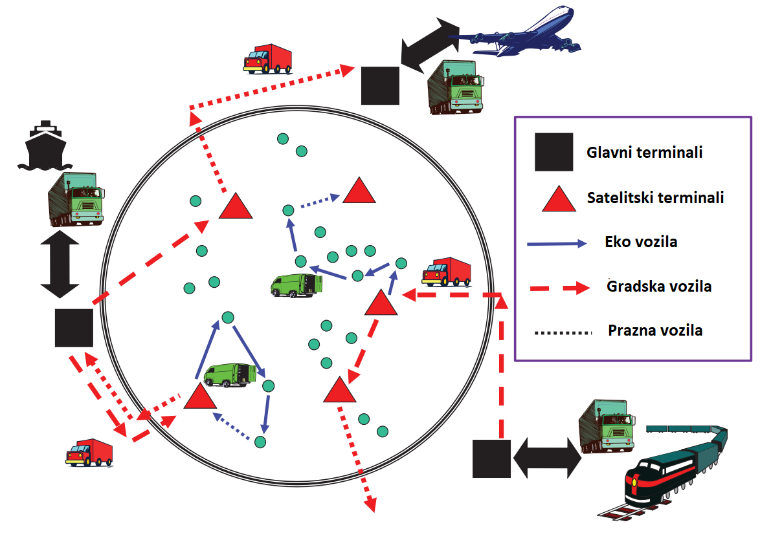
Figure 1. Two-stage city logistics (Grainic et al., 2012.)
A model for city logistics usually has a distribution center near the city center where goods are produced and/or where goods are collected from primary suppliers, and then delivered to retailers in urban areas (Faccio, 2015).
The effects of city logistics, which is organized as shown in Fig. 2. are: vehicles used for large volumes/weight are not suitable for urban transport, the use of the vehicle may be low, especially when the number of customers in the same city is not high, the number of vehicles moving in the city center for delivery of goods may be large, the distance at which the delivery takes place may be high as the effect of a low level of transport efficiency (Faccio, 2015).
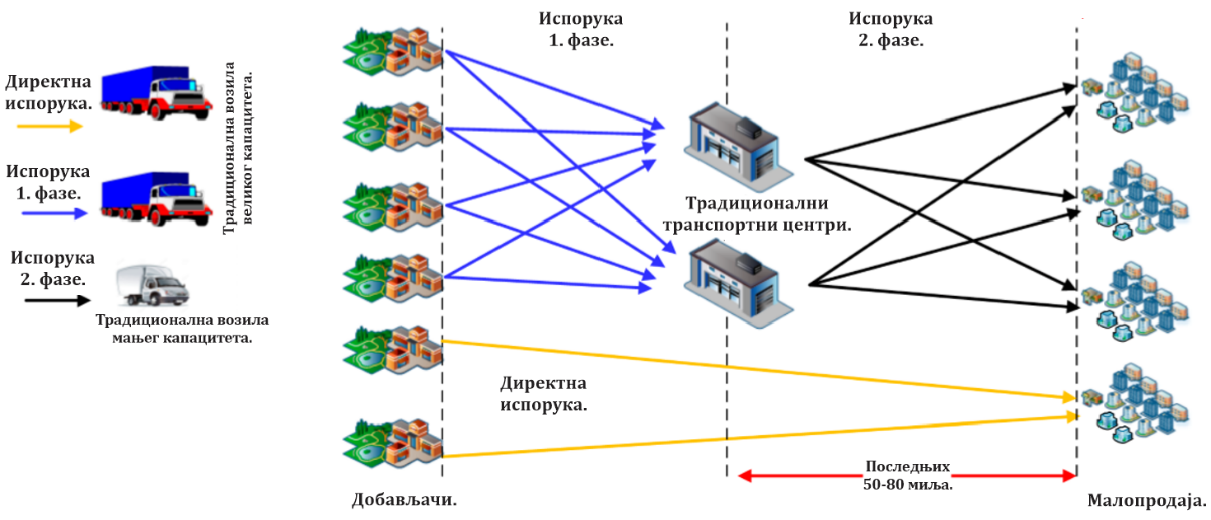
Figure 2. Schematic representation of city logistics (Faccio, 2015.)
The application of vehicles on alternative propulsion systems for the delivery of goods in the last kilometer has several advantages: reduction of traffic congestion as an effect of reducing vehicle traffic, noise reduction, pollution and vibration, reduction in shipments per trader, and increased efficiency in transport (Faccio, 2015).
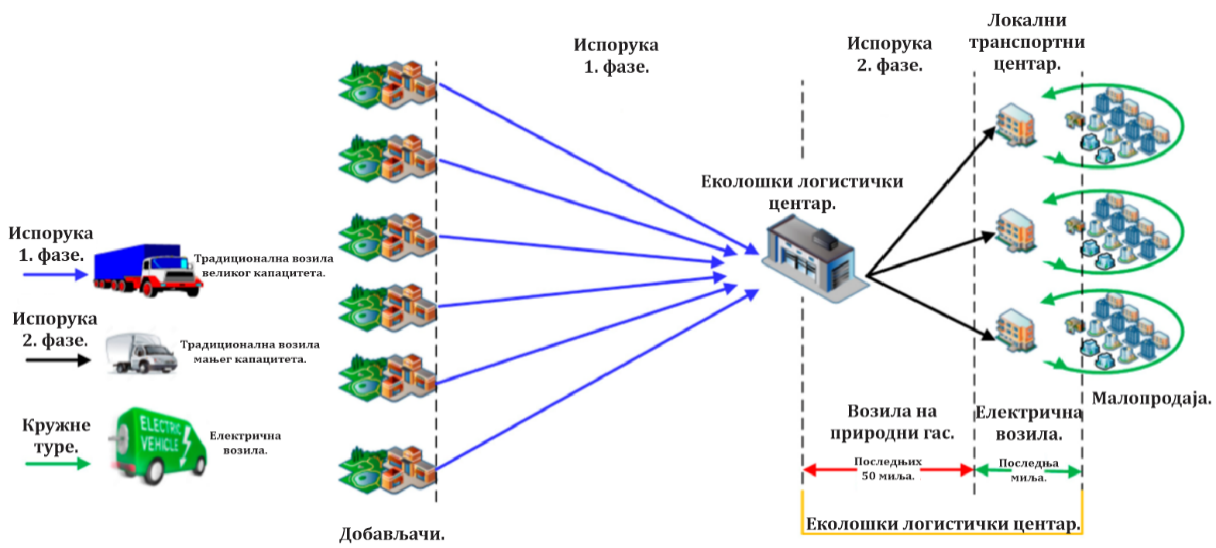
Figure 3. Innovative logistic system (Faccio, 2015.)
The main constraints of the innovative logistics system are: every city has a transport center which shows that solutions are applicable to medium-sized cities, the position of a transport center near the city center can negatively affect traffic congestion, harmful emissions and noise in urban areas, and companies often are not interested in leaving the last "step" of distribution to one of the cooperators for several reasons: revenues are limited, their brand is not visible to the retailer, and can not sell door to the door (Faccio, 2015).
Tadic, based on the existing problems, world experiences, demands for the modification of urban plans, etc. defines four concepts of CITY logistics, which clearly and precisely define the need for vehicles on alternative propulsion systems, which are (Tadić, 2014):
- CL1: Decentralized, satellite system with the dominant role of road transport.
- CL2: Centralized-decentralized system with the use of cargo trams.
- CL3: The core of the network with the use of cargo trams and electric vehicles.
- CL4: Network system with intermodal transport..
Concept CL1 implies a system of storage of goods on the perimeter of the city. For the needs of supplying the central zone, the development of satellite terminals with access road infrastructure is envisaged. The goal of satellite terminals is to transfer goods from larger to smaller delivery vehicles and consolidate flows. The function of CITY logistics terminals would be the storage and distribution of goods to vehicles on alternative propulsion systems or electric vehicles. In addition, CITY logistics terminals are envisaged to offer a return logistics service and delivery to home address (Tadic, 2014).
The CL2 concept implies the development of several CITY logistics terminals on the periphery of the central city zone. Apart from having the role of storing goods and consolidating the delivery, these centers would also develop different services in the form of logistics of return flows, delivery to home addresses, delivery to special areas for the takeover of goods. Delivery of goods from distant locations of freight and transport centers or warehouses on the periphery of the city to the nearest CITY logistics terminal would be realized by road transport, and between the CITY logistics terminals would circulate "CARGO" tram. Distribution of goods from CITY logistics terminals to generators in the gravity zone would be realized by the application of small delivery vehicles and vehicles on alternative propulsion systems (Tadic, 2014).
|
|
|
|
Figure 4. Concept CL1 (Tadic, 2013c.) |
Figure 5 Concept CL2 (Tadic, 2013c.) |
The CL3 concept is the beginning of a complex CITY logistics network with two conveyance centers on the perimeter of the city and several CITY logistics terminals on the periphery of the central city zone. This concept implies the application of rail transport between the freight transport centers and the "CARGO" tram between the goods transport centers and the associated CITY logistics terminals. The system of "CARGO" trams is also developed within the central city zone, but in the function of supply, delivery to special areas for the takeover of goods and logistics of return flows. Between the stations of "CARGO" trams and generators flows would be realized with not motorized traffic and/or using a vehicle on alternative propulsion systems (Tadic, 2014).
The CL4 concept represents the formation of a network of different categories of logistics centers and a significant involvement of the railway in the realization of flows. In the area of the central city zone, CITY logistical terminal would be developed to consolidate the supply of generators in the gravity zone, as well as the intermodal terminal. These two systems have the option of connecting rail intermodal terminals in other locations. Goods cargo terminals located on the periphery of the city would distribute goods using shuttle carts. A circular "CARGO" tram line would conduct flows between the CITY logistics terminals. Distribution of goods in the zone of CITY logistics terminals would be realized by the use of delivery vehicles on alternative propulsion systems (Tadic, 2014).
|
|
|
|
Figure 6. Concept CL3 (Tadic, 2013c.) |
Figure 7. Concept CL4 (Tadic, 2013c.) |
Zecevic (Zecevic, 2006) defines three scenarios for the development of the CBDD logistics system:
- S1: Minimum infrastructure changes scenario. Introducing new technologies into existing logistic systems for retaining the functions of the port and the railway freight station.
- S2: Significant changes scenario. The removal of a part of logistics and accompanying systems from the observed area, the modernization of the intermodal terminal, the development of CITY logistics terminals and the application of vehicles on alternative propulsion systems.
- S3: A complete change scenario. Dislocation of port and railway freight station, development of CLT minimal configuration, application of cargo trams and vehicles on alternative propulsion systems.
Scenario S1 implies retention and modernization of existing structures and subsystems in the observed area. The harbor would retain certain functions, and above all the function of intermodal transport. Bearing this in mind, further development and modernization of intermodal terminals should be expected. Existing storage and distribution systems could increase efficiency through the use of new technologies (Zecevic, 2006).
Scenario S2 involves the reduction of distribution and warehouse systems whose presence is not necessary in the CBDD area, as well as freight forwarding, customs and other activities that are not necessary for the supply of the CBD. This scenario involves IT modernization, as well as three modal node and CLT development for consolidated supply of generators in the gravity zone. This scenario would result in the reduction of railway installations, but the role of the railway in the efficient connection of this space would be strengthened. Through the CLT, CBD would be supplied with small delivery vehicles on alternative propulsion systems (Zecevic, 2006).
|
|
|
|
Figure 8. Scenario S1 of CBDD logistics system (Tadic, 2014а.) |
Figure 9. Scenario S2 of CBDD logistics system (Tadic, 2014а.) |
Scenario S3 implies the relocation of all existing facilities of the port complex and the railway freight station, and the CBDD observation area remains a business-shopping center. Delivery of goods to the CITY terminal would be realized from the logistic center at another location in the city, using "CARGO" trams, and the distribution to the generator in the area of the central city zone and the CBDD would be carried out by vehicles on alternative propulsion systems.
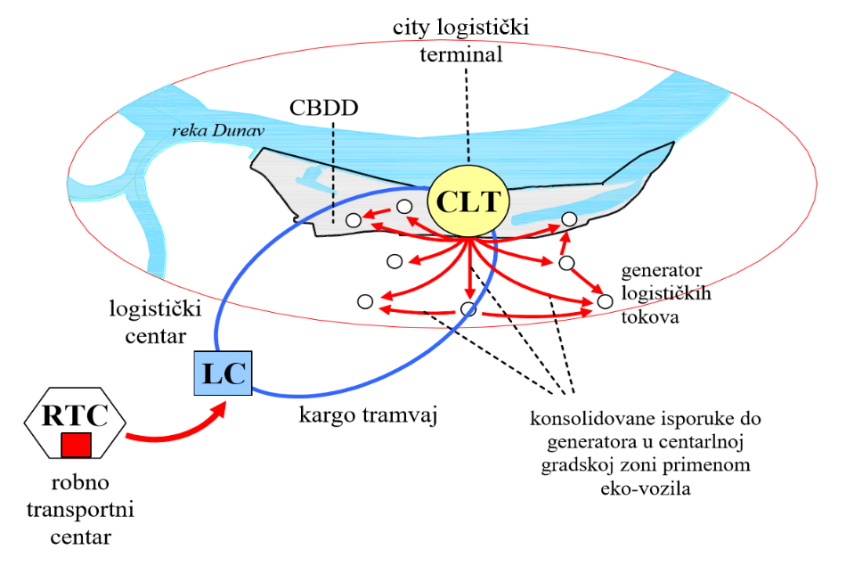
Figure 10. Scenario S3 of CBDD logistics system (Tadic, 2014а.)
Scenarios can be "delimited" based on a set of criteria (Tadic, 2014a), according to: degree of traffic congestion by heavy goods vehicles at access points and traffic infrastructures in the CBDD area, degree of space occupancy by logistics systems that are not necessary in the CBDD area, investments for the development of the system, the costs of delivery of goods, time losses in the transport of goods and services, the quality of logistics services, environmental and energy aspects, security aspects, the complexity of logistics chains, technological and visual integration of logistics systems in the urban environment.
3. Conclusions
Logistic systems should enable fast and reliable activities related to the delivery and collection of goods, which are essential for the maintenance of life in urban areas and for economic prosperity.
Freight transport has a constant growth. The functioning of cities is unimaginable without urban freight transport (Allen et al., 2003; Munuzuri et al., 2005). In European developed areas over 80% of road freight is carried out at distances up to 80 km, which is defined as urban or urban-regional transport (Ruesch and Petz, 2008). In Italy, for 70% of the transported goods final destination is located within the region of the provider. The distance of transport of over 50% of goods is up to 50 km, and for 25% within the city itself (Ewers, 1994).
With the growth of the population and the economic development of urban areas, the problems of logistics flows are also growing (Tadic, 2014). Realization of commodity flows has negative effects on the environment, traffic safety and quality of life (Tadic, 2014).
Research shows that 60% of cities have significant difficulties in managing CITY logistics, 55% of emissions are caused by distribution of goods, while 40% of goods are delivered to city centers (Wang, 2014). Every year, about 57 million people are disturbed by the noise of road transport, with 42% having serious consequences (Den Boer, 2007). At least a million years of healthy life is lost each year due to traffic noise in Europe (WHO/JRC, 2011). According to estimates, traffic noise costs amount to about 40 billion euros a year, of which 90% is from road transport (Den Boer, 2007). The energy of the transport sector is made up of oil, in 97%, natural gas 2%, electricity 1% and renewable energy less than 0.5%. In the European Union, 30% of total energy consumption is lost on transport, 43% of which are used by freight transport. The development of urban areas results in the loss of land resources. Land loss in European capitals varies between 23% and 78% (EEA, 2010c.), Of which 30% belongs to transport, mainly to road infrastructure (EEA, 2013d.). Transport in urban areas makes up about 25% of emissions of harmful gases responsible for climate change, and almost all are attributed to road transport (EEA, 2013c.). More than 1.2 million people die every year on the roads in the world (WHO, 2008). About 50 million people are injured annually in traffic accidents (WHO, 2008).
The concept of sustainability should answer the question: How can a certain part of the cargo be transported, in an efficient and environmentally friendly way, which transports goods at the shortest distance, without wasting time, with minimal costs, occupying the least land and causing minimal environmental pollution? (Melo, 2010).
Several European cities have tried to implement ecological logistics solutions in their areas. The common solution that came about was that the last kilometer of delivery would be achieved with the help of vehicles on alternative propulsion systems (Faccio, 2015).
The application of vehicles on alternative propulsion systems for the delivery of goods in the last kilometer has several advantages: reduction of traffic congestion as an effect of reducing vehicle traffic, noise reduction, pollution and vibration, reduction in shipments per trader, and increased efficiency in transport (Faccio, 2015).
References
- Allen, J., Tanner, G., Browne, M., Anderson, S., Christodoulou, G., Jones, P.: “Modelling policy measures and company initiatives for sustainable urban distribution” Final Technical Report, 2003, London.
- Den Boer, L.C., Schroten, A.: “Traffic noise reduction in Europe/Health effects, social costs and technical and policy options to reduce road and rail traffic noise”, Report, Delft, 2007.
- EC.: “EU transport in figures: Statistical pocketbook 2011”, Office for Official Publications of the European Communities, 2011a, Luxemburg.
- EC.: “Accompanying the White Paper - Roadmap to a Single European Transport Area – Towards a competitive and resource efficient transport system”, Office for Official Publications of the European Communities, 2011b, Luxemburg.
- EEA.: “The European Environment State and Outlook 2010-Land Use, State of the environment”, Report., No 1/2010., 2010c, European Environment Agency.
- EEA.: “Annual European Union greenhouse gas inventory 1990–2011 and inventory report 2013”, Technical report., No 8/2013., 2013c, European Environment Agency.
- EEA.: “A closer look at urban transport, TERM 2013: transport indicators tracking progress towards environmental targets in Europe”, 2013d, European Environment Agency.
- Faccio, M., Gamberi, M.: “New City Logistics Paradigm: From the “Last Mile” to the “Last 50 Miles”, 7, 14873-14894; doi:10.3390/su71114873, 2015.
- Grainic, G, T., Errico, F., Rei, W., Ricciardi, N.: “Integrating c2e and c2c traffic into city logistics planning”, 2012, The Seventh International Conference on City Logistics. https://ac.els-cdn.com/S1877042812005575/1-s2.0-S1877042812005575-main.pdf?_tid=1e5fb5d3-325f-4314-9a8f-342b0b90c0c3&acdnat=1532007709_db9b8e14d640b3e2272639e216a4be5d visited 19.07.2018. year.
- Munuzuri, J., Larraneta, J., Onieva, L., Cortes, P.: “Solutions applicable by local administrations for urban logistics improvement cities”, Vol. 22., No. 1., 2005., pp. 15-28.
- Melo, S.: “Evaluation of Urban Goods Distribution Initiatives towards Mobility and Sustainability: Indicators, Stakeholders and Assessment Tools”, Ph.D. Thesis, Faculdade de Engenharia da Universidade do Porto, 2010., Portugal.
- Ruesch, M., Petz, C.: “E-Commerce and urban freight distribution (home shopping) ”, Best Practice Update (2008), Updated Handbook from Year 2001, 2008., BESTUFS Consortium.
- Zecevic, S., “The development concept of the logistics system in the Ada Huja area”, Expert research, Urban Planning Institute of Belgrade, 2006., Belgrade.
- Zecevic, S., Tadic, S.: “CITY logistics”, Faculty of transport and traffic engineering, University of Belgrade, 2013. year, Belgrade.
- World Health Organization: “The global burden of disease: 2004 Update”, 2008.
- WHO/JRC (World Health Organization/Joint Research Centre): “Burden of disease from environmental noise”, Quantification of healthy life years lost in Europe, World Health Organization, 2011., Geneva.
- Wang, J., Chi, L., Hu, X., Zhou, H.: “Urban traffic congestion pricing model with the consideration of carbon emissions cost”, Sustainability 2014, 6, 2014., 676–691.

